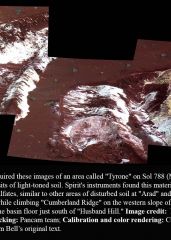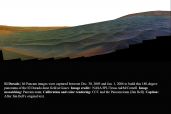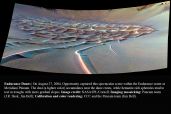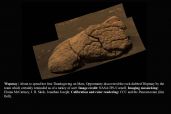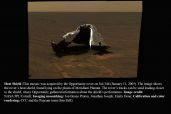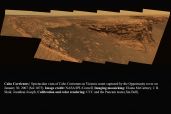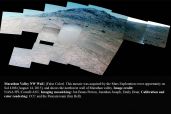After 15 years of operations, this mission was personal for all involved.
We all have our own memories, but everybody in the Mars Exploration Rover (MER) team will tell you the same thing: After 15 years of operations, this mission was personal for all of us who were part of it. We are a forever family, no matter what happens now that the last downlink has been archived and the last wake up song to Opportunity is lost in the martian wind somewhere on Meridiani Planum. Wherever life takes us, Spirit and Opportunity will always be “our little ladies” (by convention, vessels of exploration are “she”, and don’t try to convince the JPL engineers otherwise).
For a moment in time, we became the parents and guardians of mischievous twins. They each had their own personality, and both were about to write history in their own way. Spirit had to work hard from the very beginning, crawling in the dust to find invaluable nuggets of science, whereas Opportunity performed a 150-million-kilometer hole in one, landing in Eagle Crater where an outcrop was waiting to be explored. On opposite sides of the planet, both of them would demonstrate, without a shadow of a doubt, that Mars was once habitable for life as we know it. They uncovered hydrothermal environments, carbonates, sulfates, clays, hematite, shallow bodies of water, ancient dune fields, and the record of a planet pulsating between wet and dry until water disappeared from its surface.
They carried our hopes for the first extended ground exploration of a planet that may one day become a second home to humanity, and the world was happily cheering with us. We were exhilarated by their achievements and worried, all the time, about their health. Blame it on anthropomorphism, but it was easy. There were close calls, including low power, sand traps, crazy slopes, rocky paths and slippage, and the need to find “shelter for the winter.” In operational jargon, that meant finding a slope with just the right exposure and correct angle. We needed to collect enough energy on the solar panels to just stay alive when the temperatures dropped too low to continue science or driving. That necessity became a source of strategic planning and a race against time each martian year. This was especially true the first winter when we still had to learn what the rovers could endure, how far we could push them, and what we would be able to achieve together. We worked passionately together, rovers, scientists, engineers, and the project team. Our bond with them only grew deeper with time.
Spirit landed on a lava plain as flat as the back of our hands. The Columbia Hills were in sight to the east, but six months away at the rover pace. We barely had enough time to make it before winter, but we did. After a short trip north to Bonneville Crater, we turned east and never looked back. Destination: The Columbia Hills or bust! The reward of that race-for-our-life came on Sol 156 (June 11, 2004), when Spirit sent a momentous end-of-drive mosaic captured by her navigation cameras. At first glance, this black and white stereo pair looked mundane, but we all knew what it meant the moment it appeared on our screens.
Spirit’s front wheels were resting on West Spur, the foothill of the Columbia Hills, while the rear ones were still on the plain. The significance of this image could be compared to finding yourself sitting on the K/T boundary, the layer that separates the age of reptilians to that of the mammals here on Earth. That day on Mars, Spirit fell asleep for the night right on the boundary between two worlds: Early Mars that she was about to enter - a time when the planet was wetter and habitable - and the Mars we know today - dry, cold, and hostile - that she was leaving behind on the lava plains. She was entering a time machine. She would make amazing discoveries there, while completing the first ascent on Mars in the process – my kind of girl.
On the other side of the planet, Opportunity was also traveling through time, scientifically diving into ever deeper outcrops in the Eagle, Endurance, Victoria, and Endeavour craters. They both opened the martian book of stone for us,and unfolded an incredible story of a lost world of time past.
The postcards from Mars received every single Sol (a martian day) were shared with the world. If you had access to the Internet, you could routinely grab your morning coffee, go online, and be among the first humans to discover a new landscape on a faraway planet. The MER mission transformed every citizen of Earth into a planetary explorer, day after day after day, for 15 years. Every single image reminded us of how eerily similar, yet different Mars is: A sunset, a sunrise, a valley, a dune, a hill….and pretty much no atmosphere.
About a week after landing, Spirit and Opportunity cautiously left their landing carriers where they had been cocooned for the journey to Mars, and for the first time they looked back at what had been their home until that moment. The reason why the iconic “empty nest” images touched us so much was because what they truly represent is a metaphor for human destiny. How not to see the parallel between their journey and ours? How not to see ourselves in them?
While the empty nests were certainly a dual symbol of Spirit and Opportunity setting out on their own and freely roaming the immense martian landscape, they were never too far from the watchful eye of a loving and caring engineering team who bailed them out of trouble a few times. More importantly, that outstanding team often made sure to take care of trouble before it started, while allowing the science team to be bold and daring – which we never shied away from.
I vividly remember one of these times, when we received a partial panorama from Spirit in her first spring of exploration. Something did not make sense. The horizon was insanely tilted. Then, we realized: The horizon was not tilted, but Spirit was… and by more than 30 degrees! She was becoming bolder by the Sol in her attempt to reach the summit of the Columbia Hills. She was climbing alright… Many Sols later, her twin would earn her climbing badges as well, on an even steeper slope, performing transects on the outcrops of Victoria Crater, and managing to find her way out. En route to Erebus Crater, she would also have her own race against winter, fighting through a seemingly endless field of sand ripples with little energy to spare. She would get temporarily trapped in Purgatory Dune for over 5 weeks, but finally escaped to continue on towards history and broken records. Spirit was not so lucky. In 2010, she became stuck in a fine sand trap west of Home Plate. Despite all efforts, we could not get her out. We were devastated.
In many ways, Spirit story took a backseat compared to Opportunity’s. The flat plain where she landed was not as spectacular as the Eagle Crater outcrop and the “blueberries” that immediately captured people’s imaginations. Yet, in the background, she accomplished incredible technological and scientific feats in her own right and delivered equally astounding and history-making results. I don’t know why, but she reminds me of Wall-E… Covered in dust most of the time, she made it to the summit of the Columbia Hills (the equivalent of climbing the Statue of Liberty) when, like her twin, she was only supposed to drive 300 meters and survive 90 days to be able to declare the mission a success.
Spirit discovered the first carbonate outcrop on the surface of Mars. Carbonates had been previously identified on Mars, but only from orbit. There are not very many, and the reason for their scarcity remains a question today. Spirit finally found them in the Columbia Hills, where she also discovered an amazingly dynamic hydrothermal complex at Home Plate, including fumarole deposits, the dream environment needed to get life started. From her journey in the hills, we learned that all elements for habitability were present at the same time in Gusev Crater very early on. Spirit also found evidence of modern water, or possibly frost activity, in the alteration of the rocks.
Opportunity had the longevity to become an extraordinary explorer. She, too, ended up climbing hills and digging dirt. Along the way, she beat countless records and filled the planetary archives with data for generations of scientists to come. From the blueberries and acidic environments of her early years on Mars and the shiny metallic meteorites discovered along the way, to, more recently, the ancient freshwaters on the flanks of Endeavour crater, she became a marathon runner, reaching an iconic milestone in March 2015. And she left that record in the dust…literally. She will stay in the books of exploration records for being the first rover to reach 45 kilometers. If that mission suffered from one thing, it was from overachievers, on both the human and rover sides.
Spirit and Opportunity were remarkable. Other incredible rovers will come; one already has. They will be better, bigger or smaller, and smarter. They will write their own chapters of exploration history, but Spirit and Opportunity will forever remain the originals. They took us on the journey of their lifetime into the discovery of our neighborhood, out of our planetary cradle. They helped us map the unknown and take baby steps towards becoming an interplanetary civilization.
They are now resting where they belong. The dust that will collect on their solar panels will be blown by the capricious winds of the thin martian atmosphere. They are forever surrounded by open panoramas of sunrises and sunsets, not confined by the walls of a museum. They rest surrounded by the breathtaking landscapes they boldly explored for so many years and can proudly look back at the road covered. They are sleeping for now, just waiting for us, for when the time comes to reunite. When that day comes, we will have finally accomplished what they prepared us for. We will wake them up and we will resume exploration side-by-side.
My Personal Journey to Mars with Spirit
I became a member of the MER science team in 2002, after being selected by the NASA Mars Program, but my connection with Gusev crater, and ultimately Spirit, goes back much, much earlier, to 1986 to be precise. My Master’s thesis included a study of Ma’adim Vallis, a large martian channel. Its outlet was located in a 170-km diameter impact crater named Gusev Crater. I continued to study Gusev for my Ph.D. thesis, mapping it as part of the history of water on Mars, which was the subject of my thesis. In 1990, I spent a month at Brown University, Providence (RI), to analyze Viking mission images. There, I met Jim Head and his planetary group, which connected me to the Russian colleagues collaborating with them. Little did I know at the time that the Russians wanted to develop a rover exploration program with two missions, Mars 94 and 96. They were interested in Gusev crater as a landing site for their first mission. That got me a ticket to Moscow a few months later to present my study. Mars 94/96 never happened, but the interest in Gusev started to grow. I traveled to Arizona State University in late October 1993 to work with a student of Ronald Greeley and Jack Farmer, both of whom would also become MER science team members. I helped with her mapping of the Ma’adim/Gusev region. Then, I went back to my lab in France. I could not imagine then that Gusev would completely change my life and put me on a collision course with Spirit ten years in the future. The wheels had been set in motion. A few months later, a meeting at the Observatory of Meudon (France) with Chris McKay was the turning point. He had a concept for an exobiology mission, but no landing site. By then I had a solid study, and Gusev was an amazing site for astrobiology. I also had nowhere to go. My lab in France was closing, and I did not have any job prospects. I only had 9-months of postdoc money in my pocket. McKay invited me to NASA Ames Research Center to evaluate potential traverses of astrobiological interest in Gusev. I took a leap of faith and arrived in California in late October 1994. I have called it my home ever since.
Here are a few milestones along the way:
- 1994-1998. My National Research Council report focused on the feasibility of Gusev Crater for an exobiology mission. I became the Deputy Science Lead for the rover field experiments that Carol Stoker was leading at NASA Ames. Ironically, our test rover was one of the Marsokhod rovers that the Russians wanted to use for their Mars 94/96 missions. I learned the ropes of rover science operations then and became the Science Lead for the Nomad rover field experiment in the Atacama Desert in 1998.
- 1998-2001. I assembled the data for a series of publications about ancient impact crater lakes on Mars and published a number of monographs and global studies on Gusev and other potential martian lakes with Edmond Grin. Together, we participated in landing site selection workshops for the Pathfinder and Mars Surveyor 2001 lander missions. Gusev was not a good fit for either of them. In 1999, NASA lost the Mars Climate Orbiter and the Deep Space missions. The 2001 lander mission was canceled. The Mars Odyssey orbiter was launched to recover climate science, and the MER mission concept was fast-tracked. The time had come.
- 2001-2002. I advocated for Gusev at the three MER landing site selection workshops. Candidate sites had to fulfill science and engineering constraints. Gusev made it to the third workshop. From more than 120 candidates at the beginning of the process, we were down to four. There were safety concerns for Gusev, with the possibility of high winds at landing. I was not too optimistic during the first round of votes. More discussions came before the second round. Gusev made the cut with Meridiani, along with a backup site. I barely heard the result of the vote. A journalist already had a microphone pinned on me asking “how it felt to win” (by then, my nickname in that community was “Mrs. Gusev”). I did not know. I was stunned. It was not a done deal yet. More analyses were needed, and final approval would come from NASA, but Gusev had survived against many odds. The room emptied. I was with Edmond, and we walked for 40 minutes on Colorado Boulevard in Pasadena before being able to articulate a single word. The two of us had left France eight years earlier with one suitcase. In that suitcase, there was a folded mosaic of printed Viking images taped together: that of Gusev Crater.
- 2002-2003. It was early morning when the phone rang in my office. Steve Squyres, the Principal Investigator of the MER mission, was calling to let me know that I had been selected as a member of the Mars Exploration Rover science team. Blank. Steve joked to fill the silence that followed and told me: “That does not mean we are going to Gusev…yet.” I think he loved that site as much as I did. That got me laughing. He also mentioned that he would call me back later that morning, but for now, he needed to go. He hung up. I looked at Edmond who was sharing the office with me at NASA Ames. The only thing I was able to say was: “We are going to Mars.”
Moments in Time
Although we could staff both rovers at any time, I decided to focus on Spirit. Overall, I may have taken part in maybe two days of operations with Opportunity. I still followed Oppy’s progress closely, even after Spirit stopped operations. They were both incredible rovers, but I felt a special connection with Spirit and Gusev. Below are my moments in time with her. All members of the MER missions have their own favorite memories, all equally personal, I am sure.
- We were given a tour of the High Bay during the first team meeting at JPL. Down below, Spirit’s frame was taking shape. She was perched on a table, still missing some wheels and parts. On the opposite side of the room, engineers in bunny suits were tying knots around the heat shield. It dawned on me that the next time I would see them would be in Gusev.
- Gusev and Meridiani were confirmed as the two landing sites. It’s hard to describe the feelings that came over me and Edmond. Everything was happening so fast now, after so many years of battling and trying to convince colleagues. Ultimately, both Gusev and Meridiani were choices made by the scientific community and the Mars Program. It had been a long road. During our first team training at JPL before the mission, Pete Theisinger, the MER project manager then, entered the room, pointed at me laughing, and said: “We got you your Gusev!” He gave me the biggest bear hug.
- Spirit left for Kennedy Space Center in Florida in the cover of darkness around midnight in an unmarked truck. She was escorted across country by unmarked police vehicles. Opportunity would follow a few weeks later. The road to another world started there. They were saluted as they crossed the JPL gates.
- Launch time at Kennedy. Spirit was nested on top of the Delta rocket. We were in an auditorium for the prelaunch activities. The NASA Administrator, program directors from NASA Headquarters, project team members, and managers were speaking. I remember their gratitude for how the country had come together for this mission and how so many had contributed. Some of them had made it to the launch. There was a woman sitting in front of me who had sewn the airbags that cushioned the rovers landing. This is burned in my memory. She was not a rocket scientist nor did she belong to NASA, but without her and so many others, the MER mission would never had made it.
- The weather was not cooperating and afternoon thunderstorms delayed Spirit’s launch for a few days. That was an opportunity for a little free time. Edmond and I took long walks on Cocoa Beach, enjoying the view of the launch pad in the background where Spirit was patiently waiting on top of that rocket for her time to go. After a few days, we took that same walk again, now looking at the empty launch pad. Spirit was gone and was on her own. We had just returned from a picture-perfect launch in early afternoon. First came the brightest light I had ever seen, then heard thunder like I never heard before. It came roaring and hit us in the chest like a truck. By the time it reached us, Spirit was already clearing the clouds way, way up there. Then I decided to forget about the mission for the next 6 months – completely. So many things could go so wrong between here and Mars and it had taken so much to simply get to that moment. Just to get started. I did not even want to think about it.
- Landing time. I was going back and forth between the science operations room and the guests’ room at JPL. Entry and descent went like clockwork. Spirit hit the ground hard and bounced back high, very, very high. Winds were stronger than models thought safe, and she bounced along the surface for a long while… then she called home. We all went nuts, cheering and hugging. Then, Spirit went silent. Nothing for the longest 15 minutes. Here on Earth, we were looking for her with every antenna available. I remember distinctly thinking, “We can’t lose you now,” but I barely had time to finish that thought that someone screamed, “We got her! We got her!” And so, it began. Everything was surreal. We went up and down between buildings. Elevators opened – whoever was in there, we hugged. My head was spinning, I mean, literally. Back in the guests’ room, Dave Lavery from HQ grabbed me by the arms and before I knew it, I was spinning around. We were elated.
- Later that night, Spirit sent her first images. After 18 years of looking at orbital imagery, Edmond and I finally saw Gusev from the ground for the first time.
- The same overwhelming joy was there when Opportunity landed three weeks later, with an added touch of mystery. I looked at her first black and white, low resolution panorama and could not make sense of that white stuff in front of the lander. The first thing I thought of was that we had scattered hardware everywhere, like bits of airbags. Who knew? Then, I realized that it did not make any sense. She would not be communicating if that was the case. My geologist’s brain finally kicked in, and the curvature of the horizon gave it away: We were in a crater. Hole in one, and this was an outcrop. Pay dirt! We landed on it.
- In the six months of primary science operations at JPL, I spent a lot of time in the engineering room before daily science operations started. Due to the martian jet lag, it was sometimes in the middle of the night. The engineers were receiving data from the rover, and together we looked at images. Whenever they asked, I would comment on them. We were the first humans on this planet to discover these new alien landscapes.
- Spirit decided to take a short-cut on West Spur and capture a panorama while her wheels were resting at a 30-degree angle. Artistic.
- The solar panels were completely covered in dust. We lamented about the (direly low) power that continued to plunge as the days passed. We could not do much science or driving. The next day, John Grant came into the Science Operation Working Group (SOWG) room, and looked incredulous. Power was back up and about as high as could be for that season. There had to be a mistake. How was this possible? The next image downlink revealed the culprit, caught by Spirit’s camera. A dust devil had passed over the rover, completely clearing her panels. We were back in business. Dust devils would help us on both sides of the planet a number of times over the years.
- There was a night in 2004, around 3:00 a.m., at JPL when I decided that for once I would look into the folder of new atmospheric data that had just arrived. I never used to look at it since I was a member of the geology group, not the atmosphere group. I opened one image and started scratching my head. A long streak was cutting through a good part of the image. I called Jason Soderblom who was the only other one around at that time for the science team. It could not be a cosmic ray. We wondered if Spirit had captured the tail end of Odyssey’s pass, while doing pre-dawn astronomy observations. For several days, the science team investigated. We thought about all possible orbiters, including the old Viking, but none of the schedules worked. It turned out that Spirit had captured a meteor by accident.
- Spirit summitted the Columbia Hills. She was the first climber on another world. From there, she captured the so-called “Everest” panorama. For her, it had been the Everest, and the view was breathtaking. Soon, Home Plate came into view to the south. The high rim of Gusev was visible in the distance. Thira was also visible to the east. There too, for the first time, we finally saw the 20+/-km diameter impact crater from the ground. Edmond and I had suggested its name to the IAU, and it had been accepted. Another symbol left in the rocks. It means a lot to the two of us.
Spirit made her greatest discoveries from that point on, helping us decipher a past of more clement times and a much more dynamic planet of explosive volcanism, fumaroles, and carbonate and salt deposits. Sol after sol after sol, Spirit advanced and we mapped. Each turn of the wheels brought exploration and discoveries. Early Mars was habitable for life as we know it. It was written in stone.
Spirit was lost in 2010. The time had come to say goodbye. The time had come for me to move on as well and think about my own next step. I took a leave without pay that year. I needed space to think. I cleared my desk of reports and wrote papers, projects, and proposals the entire year. That path would ultimately take me back to Chile. The next logical step in exploration was to search for biosignatures. I am endeavoring today to understand how we can achieve this in the thin air of the High Andes. In a landscape eerily similar to that of Gusev, I crawl in dirt, covered in dust, study fumaroles and lakes, and climb volcanoes; from their summit, I look down at dust devils roaming the altiplano.
Captions and images below are from the NASA Photojournal and the Pancam Gallery where the MER images are archived. I invite you to visit those two links: https://photojournal.jpl.nasa.gov/targetFamily/Mars and http://pancam.sese.asu.edu
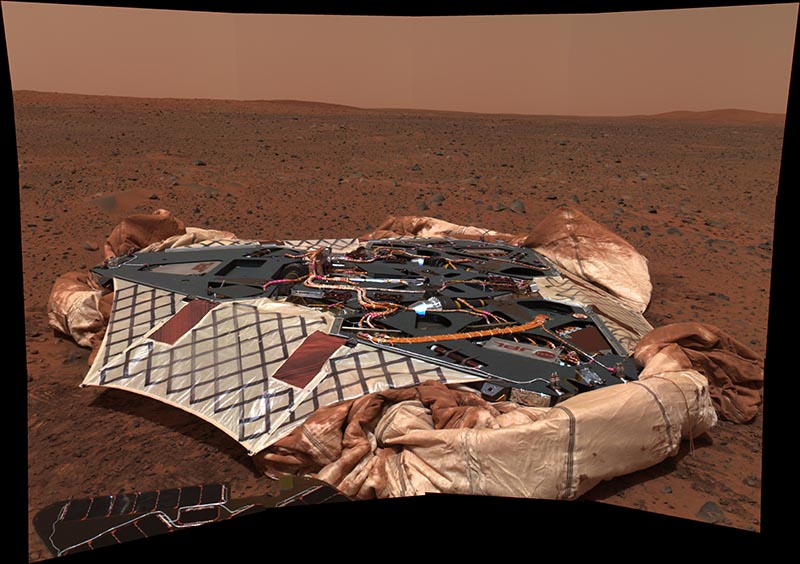
Empty Nest | This image shows the Spirit rover's landing site, the Columbia Memorial Station, at Gusev Crater, Mars. This spectacular view may encapsulate Spirit's entire journey, from lander to its possible final destination toward the east hills. On its way, the rover will travel 250 meters (820 feet) northeast to a large crater approximately 200 meters (660 feet) across, the ridge of which can be seen to the left of this image. To the right are the east hills, about 3 kilometers (2 miles) away from the lander. The picture was taken on the 16th martian day, or sol, of the mission (Jan. 18/19, 2004). A portion of Spirit's solar panels appear in the foreground. Data from the panoramic camera's green, blue and infrared filters were combined to create this approximate true color image. Image credit: NASA/JPL/Texas A&M/Cornell.
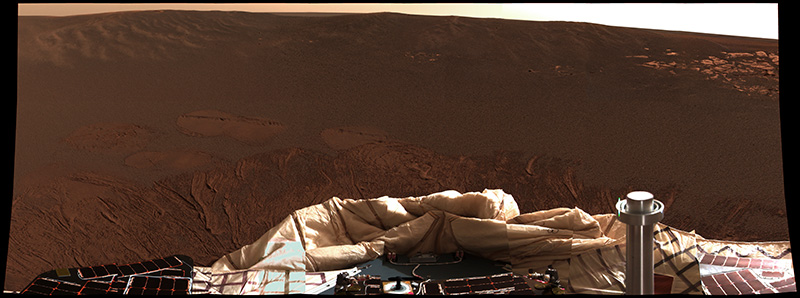
A Hole in One | The interior of a crater surrounding the Mars Exploration Rover Opportunity at Meridiani Planum on Mars can be seen in this color image from the rover's panoramic camera. This is the darkest landing site ever visited by a spacecraft on Mars. The rim of the crater is approximately 10 meters (32 feet) from the rover. The crater is estimated to be 20 meters (65 feet) in diameter. Scientists were intrigued by the abundance of rock outcrops dispersed throughout the crater, as well as the crater's soil, which appeared to be a mixture of coarse gray grains and fine reddish grains. Image credit: NASA/JPL/Cornell. Image mosaicking: Cornell Pancam team; Calibration and color rendering: CCC and the Pancam team (Jim Bell). Caption: After Jim Bell’s original text.

Two Worlds | NASA's Mars Exploration Rover Spirit took the images that make up this 360-degree panorama with its navigation camera on sol 156 (June 11, 2004). The image highlights Spirit's arrival at the base of the "Columbia Hills." Since landing at Gusev Crater, Spirit has put more than 3.4 kilometers (2.1 miles) on its odometer. Much of this can be attributed to the long drives the rover undertook to reach these interesting landforms. Near the center of the panorama, the margins of the lava plain and the Columbia Hills are fading into each others, bridging two worlds. To the left, an earlier, wetter, habitable Mars had turned into the cold, dry and hostile planetary surface we know today. Credit image: NASA/JPL/Cornell. See full size image at: https://photojournal.jpl.nasa.gov/tiff/PIA06279.tif
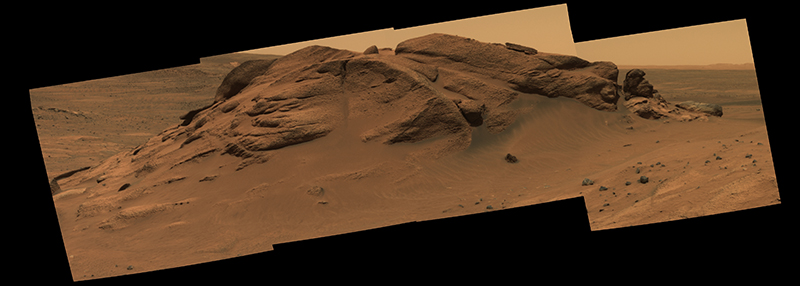
Carbonates | This mosaic was acquired by the Mars Exploration Rover Spirit on Sol 695 (December 16, 2005). Spirit encountered Comanche on her way to Home Plate, during her descent of Husband Hill. The outcrop is roughly 6 meters across, and unusually rich in magnesium-iron carbonate minerals. Its discovery marked the first time carbonates were identified from the ground on Mars. Image credit: NASA/JPL/Texas A&M/Cornell. Image mosaicking: Pancam team; Calibration and color rendering: CCC and the Pancam team (Jim Bell). Caption: After Jim Bell’s original text.

Everest Panorama | It took Spirit three days, sols 620 to 622 (Oct. 1 to Oct. 3, 2005), to acquire all the images combined into this mosaic, called the "Everest Panorama," looking outward in every direction from the true summit of "Husband Hill." During that period, the sky changed in color and brightness due to atmospheric dust variations, as shown in contrasting sections of this mosaic. Haze occasionally obscured the view of the hills on the distant rim of Gusev Crater 80 kilometers (50 miles) away. As dust devils swooped across the horizon in the upper right portion of the panorama, the robotic explorer changed the filters on the camera from red to green to blue, making the dust devils appear red, green, and blue. In reality, the dust devils are similar in color to the reddish-brown soils of Mars. No attempt was made to "smooth" the sky in this mosaic, as has been done in other panoramic-camera mosaics to simulate the view one would get by taking in the landscape all at once. The result is a sweeping vista that allows viewers to observe weather changes on Mars. The summit of Husband Hill is a broad plateau of rock outcrops and windblown drifts about 100 meters (300 feet) higher than the surrounding plains of Gusev Crater. In the distance, near the center of the mosaic, is the "South Basin," the destination for the downhill travel Spirit began after exploring the summit region. This panorama spans 360 degrees and consists of images obtained during 81 individual pointings of the panoramic camera. Four filters were used at each pointing. Images through three of the filters, for wavelengths of 750 nanometers, 530 nanometers and 430 nanometers, were combined for this approximately true-color rendering. Image Credit: NASA/JPL-Caltech/Cornell. NASA Photojournal ID PIA03095.
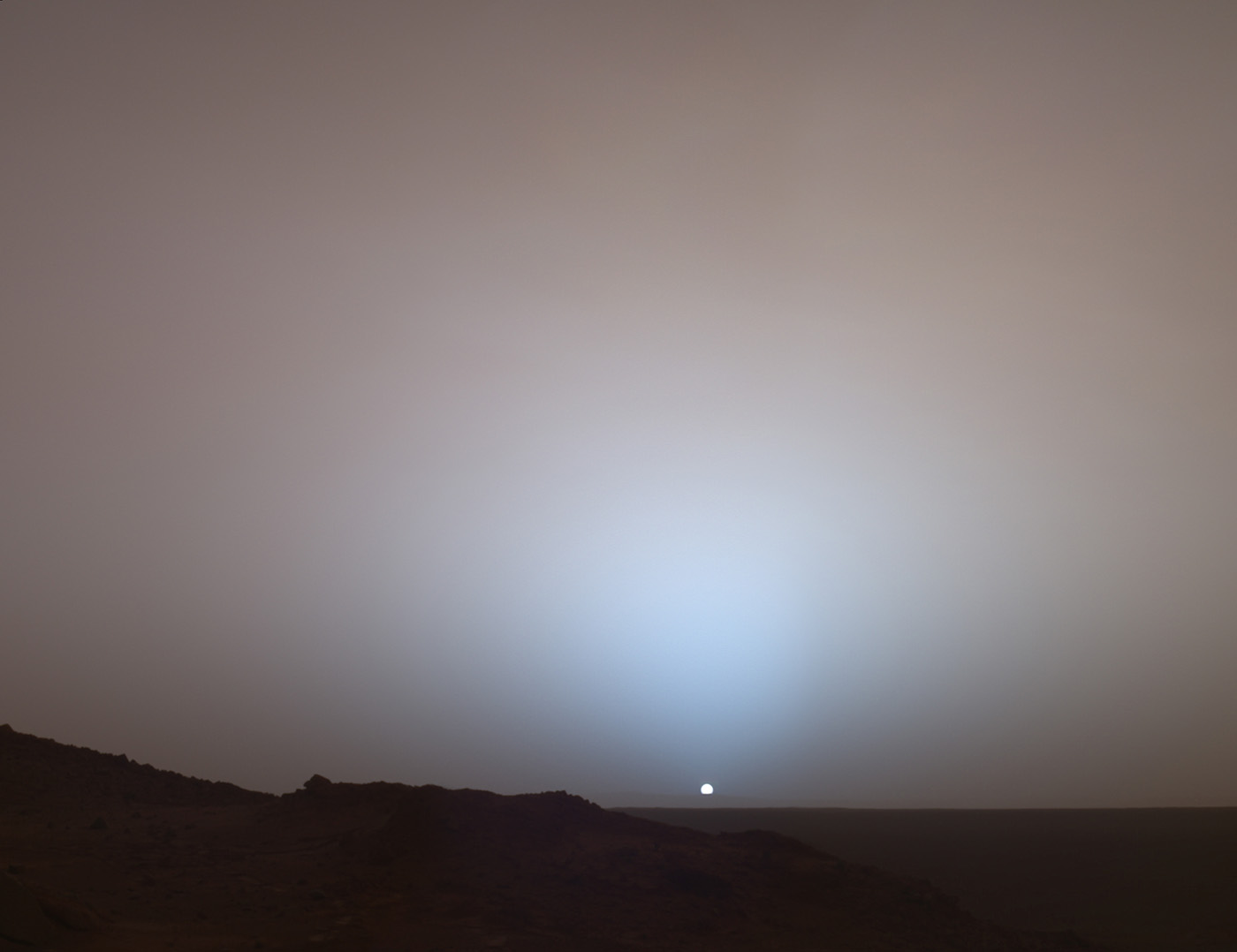
Sunset at Gusev | On May 19th, 2005, Spirit captured this stunning view as the Sun sunked below the rim of Gusev crater. This mosaic was taken around 6:07 pm martian time, on the rover’s 489th martian day. The floor of Gusev Crater is visible in the distance, and the Sun is setting behind the wall of Gusev some 80 km (50 miles) in the distance. Image credit: NASA/JPL/Texas A&M/Cornell. Image mosaicking: Pancam team; Calibration and color rendering: CCC and the Pancam team (Jim Bell). Caption: After Jim Bell’s original text.

